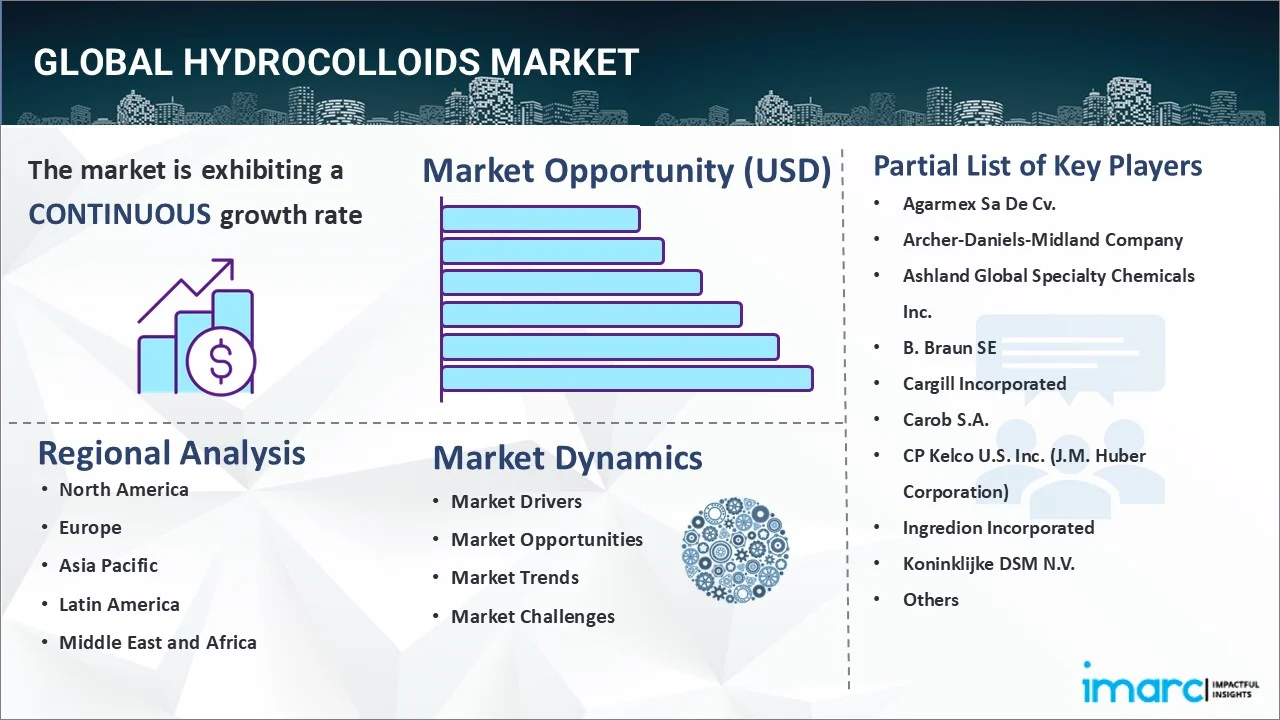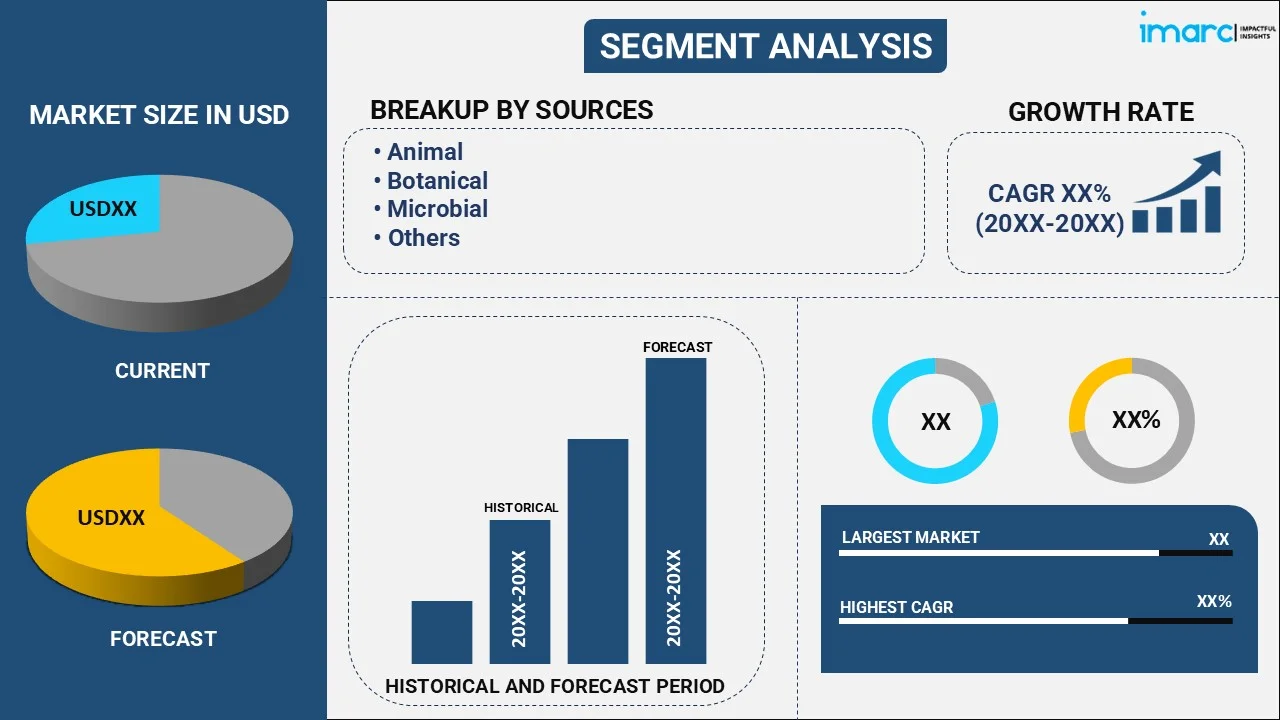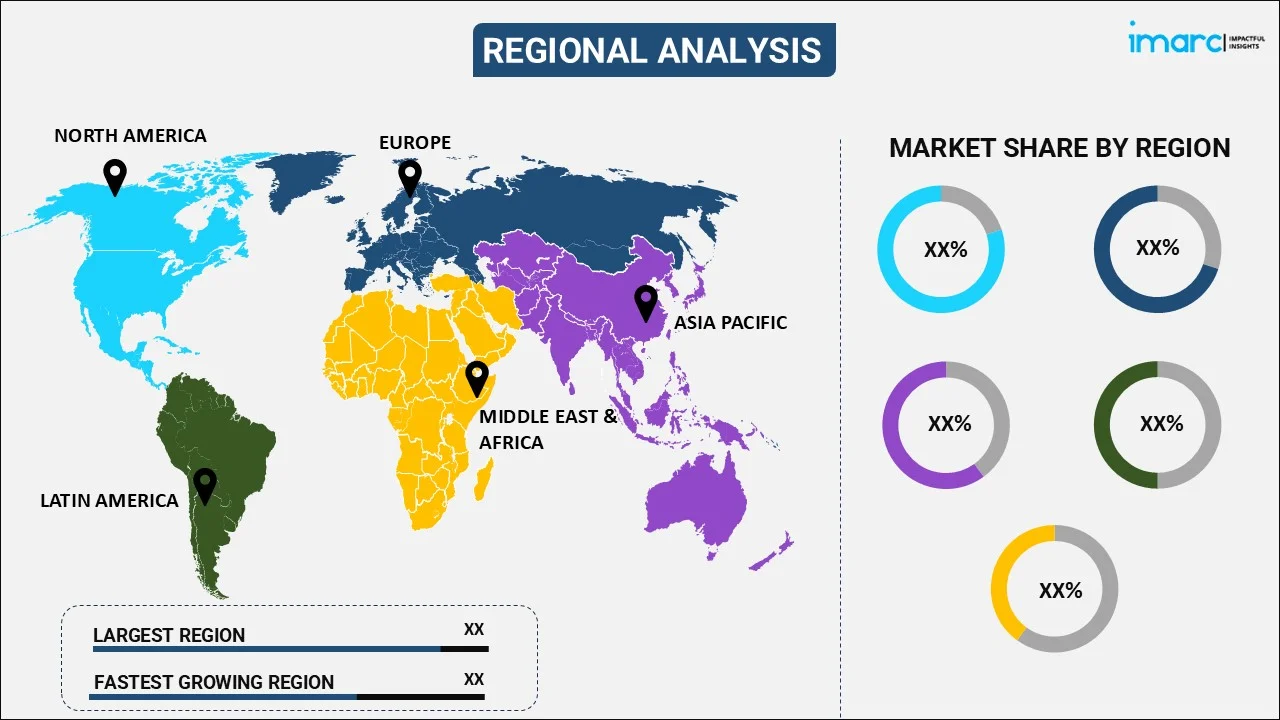
Hydrocolloids Market Report by Source (Animal, Botanical, Microbial, Seaweed, Synthetic), Product (Gelatin, Xanthan Gum, Carrageenan, Guar Gum, and Others), Function (Thickening, Gelling, Stabilizing, and Others), Application (Food and Beverages, Personal Care and Cosmetics, Pharmaceuticals), and Region 2025-2033
Hydrocolloids Market Size:
The global hydrocolloids market size reached USD 12.5 Billion in 2024. Looking forward, IMARC Group expects the market to reach USD 18.1 Billion by 2033, exhibiting a growth rate (CAGR) of 4.17% during 2025-2033. Asia Pacific represents the leading segment owing to the heightened consumer preference for natural, plant-based ingredients. Additionally, the market growth is significantly propelled by the escalating demand across key industries like personal care, food, and pharmaceuticals. In addition, improved product applications in wound care and drug delivery processes, heightened utilization of natural ingredients, and rising adoption in plant-derived products are fostering substantial market expansion and innovation.
|
Report Attribute
|
Key Statistics
|
|---|---|
|
Base Year
|
2024
|
|
Forecast Years
|
2025-2033
|
|
Historical Years
|
2019-2024
|
|
Market Size in 2024
|
USD 12.5 Billion |
|
Market Forecast in 2033
|
USD 18.1 Billion |
| Market Growth Rate (2025-2033) | 4.17% |
Hydrocolloids are high molecular weight hydrophilic polymers that form a colloidal dispersion in water. They are extracted from plants, animals, seaweeds, and microbials. Pectin, carrageenan, gelatin, alginates, agar, carboxy methyl, and guar gum are some commonly used hydrocolloids. They are widely incorporated in beverages, bakery products, dairy, frozen food, confectionery, seafood, oils, and fats. Hydrocolloids improve the textural properties and act as thickeners, water retention agents, stabilizers, emulsifiers, and gel-forming agents. They also provide a moist and insulating healing environment that protects uninfected wounds, treats acne blemishes, and reduces inflammation and skin redness. As a result, hydrocolloids find extensive applications across the food and beverage (F&B), pharmaceutical, personal care, and cosmetics industries.

To get more information on this market, Request Sample
Hydrocolloids Market Trends:
Increasing Demand for Convenience and Processed Foods
The demand for hydrocolloids is on the rise as people increasingly depend on ready-to-use meals, processed snacks, and packaged drinks. As people become more urbanized and lead more hectic lifestyles, they require foods that are easy to prepare but retain their taste, texture, and shelf life. Hydrocolloids are found to be a key factor in improving these characteristics by stabilizing emulsions, managing moisture, and enhancing viscosity. Manufacturers are increasingly using hydrocolloids like xanthan gum, carrageenan, and guar gum to attain the consistency of products in a desirable manner while maintaining long-term freshness. The market for bakery, dairy, confectionery, and beverage items is growing, and hydrocolloids are acting as critical ingredients in their formulation. As consumers are giving emphasis to convenience without sacrificing quality, businesses are finding ways to innovate with hydrocolloid uses to provide differentiated food experiences. This increasing dependence on convenience food items is consistently propelling market growth in both developed and emerging economies worldwide within the food industry. As per State of Snacking: Future Trends report by Mondelēz International, around 60% of consumers worldwide favor smaller meals or snacks throughout the day rather than a few big meals. A reported 65% of consumers view "the convenience of preparation" as a significant criterion when selecting food and beverage products in 2024.
Increasing Transition Towards Natural and Plant-Based Ingredients
The market for hydrocolloids is growing since consumers are increasingly looking for natural, clean-label, and plant-based food products. With heightened awareness about health, sustainability, and environmental issues, food and beverage companies are moving aggressively to substitute synthetic additives with naturally derived hydrocolloids. Plant-based gums, seaweed derivatives, and pectin are increasingly employed as gelling, thickening, and stabilizing agents. The movement is facilitated by the increased take-up of vegan and vegetarian diets, whereby hydrocolloids are serving as focal replacements for animal-derived ingredients in dairy-free alternatives, confection, and plant-based meats. Companies are repeatedly highlighting the natural nature of hydrocolloids as a way to target health-aware consumers increasingly critically examining product labels. Besides, regulatory bodies are promoting clean-label programs, which also encourage manufacturers to adopt plant-based solutions. In January 2025, YouGov and Veganuary conducted a joint study revealing that around 25.8 million individuals worldwide experimented with veganism.
Broader Applications in the Pharmaceutical and Healthcare Industries
The market for hydrocolloids is showing strong growth since pharmaceutical and healthcare sectors are making greater use of hydrocolloids in various formulations. Hydrocolloids are being used as excipients in drug delivery systems, where they are managing release rates, enhancing bioavailability, and providing stability. Hydrocolloid dressings are widely utilized in management of wound care owing to their moisture-retentive and healing characteristics. The consumption of nutraceuticals and functional supplements is also on the rise, and hydrocolloids are being used in capsule coatings, suspensions, and controlled delivery formulations. The aging population and increased incidence of chronic diseases are boosting pharmaceutical research and development (R&D), with hydrocolloids being key ingredients in sophisticated therapeutic products. Healthcare professionals are using hydrocolloid-based therapies for patient treatment, given their safety, biocompatibility, and efficacy. As pharmaceutical research continues to improve, the use of hydrocolloids as an additive in drug formulation, controlled drug release, and wound healing products is on the rise, driving sustained demand in the medical and healthcare sectors globally. IMARC Group predicts that the global nutraceuticals market is expected to attain USD 877.8 Billion by 2033. This will further drive the need for effective hydrocolloids in the coming years.
Hydrocolloids Market Growth Drivers:
Growing Application in Cosmetics and Personal Care Formulations
The market for hydrocolloids is growing with cosmetic and personal care makers increasingly using hydrocolloids because of their thickening, stabilizing, and emulsifying capabilities. Hydrocolloids are being applied extensively in lotions, creams, shampoos, and gels for their texture-enhancing, spreadability, and moisture-holding properties. Natural and safe cosmetics are in high demand among consumers, and plant and seaweed-based hydrocolloids are fulfilling this need. In cosmetics, hydrocolloids are contributing to the creation of hydrating masks, soothing gels, and wound-healing patches in the field of skincare. Hydrocolloids are boosting product performance in hair care through enhanced consistency and longer-lasting conditioning. With the clean beauty and sustainable formulation trend on the rise, hydrocolloids are being marketed as an eco-friendly option to synthetic chemicals, allowing cosmetic companies to innovate and differentiate products in an intensely competitive marketplace. Increasing social media makeup trends and high-end skincare needs are also driving up the adoption of hydrocolloids in personal care further.
Food Processing and Product Innovation with Technological Advancements
The hydrocolloids sector is developing at a robust pace as food processing technological progress is allowing for innovative applications. Manufacturers are now investing more in sophisticated processing methods to enhance hydrocolloids' functional characteristics, including solubility, stability, and compatibility with other food materials. New foods are being formulated to satisfy consumer requirements for reduced sugar, low-fat, and gluten-free options without sacrificing flavor or texture. Hydrocolloids are at the center of these developments by allowing product developers to match desired sensory qualities. The evolution of precision processing technologies is also enabling greater customization of hydrocolloid formulations to address specific functionalities. With consumer tastes evolving at a rapid pace, food manufacturers are constantly testing hydrocolloids to introduce new products across the bakery, dairy, beverage, and meat substitute categories.
Increased Demand from Developing Economies
The hydrocolloids industry is growing enormously due to the emergence of economies as these are experiencing the growth of food, pharmaceutical, and cosmetic industries at a very fast rate. Urbanization, increase in disposable income, and changing eating habits are fueling greater consumption of packaged and processed foods, where hydrocolloids are emerging as core functional ingredients. Local companies are adding more hydrocolloids to enhance product stability and shelf life for growing middle-class consumers that prioritize convenience and quality. Developing countries' pharmaceutical sectors are also incorporating hydrocolloids into formulations and wound care, mirroring increased healthcare infrastructure. Cosmetics companies within these countries are also adopting hydrocolloids to meet the growing consumer demand for affordable yet effective skincare and personal care products. The increasing penetration of international food and cosmetic brands in these economies is further driving hydrocolloid uptake.
Hydrocolloids Market Segmentation:
IMARC Group provides an analysis of the key trends in each segment of the market, along with forecasts at the global, regional, and country levels for 2025-2033. Our report has categorized the market based on source, product, function, and application.
Breakup by Source:

- Animal
- Botanical
- Microbial
- Seaweed
- Synthetic
Animal accounts for the majority of the market share
The report has provided a detailed breakup and analysis of the market based on the source. This includes animal, botanical, microbial, seaweed, and synthetic. According to the report, animal represented the largest segment.
Breakup by Product:
- Gelatin
- Xanthan Gum
- Carrageenan
- Guar Gum
- Others
A detailed breakup and analysis of the market based on the product have also been provided in the report. This includes gelatin, xanthan gum, carrageenan, guar gum, and others.
Breakup by Function:
- Thickening
- Gelling
- Stabilizing
- Others
Stabilizing represents the leading market segment
The report has provided a detailed breakup and analysis of the market based on the function. This includes thickening, gelling, stabilizing, and others. According to the report, stabilizing represented the largest segment.
Breakup by Application:
- Food and Beverages
- Personal Care and Cosmetics
- Pharmaceuticals
Food and beverages exhibit a clear dominance in the market
A detailed breakup and analysis of the market based on the application have also been provided in the report. This includes food and beverages, personal care and cosmetics, and pharmaceuticals. According to the report, food and beverages accounted for the largest market share.
Breakup by Region:

- North America
- United States
- Canada
- Asia-Pacific
- China
- Japan
- India
- South Korea
- Australia
- Indonesia
- Others
- Europe
- Germany
- France
- United Kingdom
- Italy
- Spain
- Russia
- Others
- Latin America
- Brazil
- Mexico
- Others
- Middle East and Africa
Asia Pacific leads the market, accounting for the largest hydrocolloids market share
The report has also provided a comprehensive analysis of all the major regional markets, which include North America (the United States and Canada); Europe (Germany, France, the United Kingdom, Italy, Spain, Russia, and others); Asia Pacific (China, Japan, India, South Korea, Australia, Indonesia, and others); Latin America (Brazil, Mexico, and others); and the Middle East and Africa. According to the report, Asia Pacific represents the largest regional market for hydrocolloids.
Competitive Landscape:
The market research report has also provided a comprehensive analysis of the competitive landscape in the market. Detailed profiles of all major companies have also been provided. Some of the companies covered include:
- Agarmex Sa De Cv.
- Archer-Daniels-Midland Company
- Ashland Global Specialty Chemicals Inc.
- B. Braun SE
- Cargill Incorporated
- Carob S.A.
- CP Kelco U.S. Inc. (J.M. Huber Corporation)
- Ingredion Incorporated
- Koninklijke DSM N.V.
- Nexira
- Palsgaard A/S
- Rousselot (M) SDN. BHD. (Darling International Inc.).
- Tate & Lyle PLC
Kindly note that this only represents a partial list of companies, and the complete list has been provided in the report.
Hydrocolloids Market News:
- In June 2025, DKSH’s Business Unit Performance Materials, a top supplier of specialty chemicals and components, will offer business development, marketing, sales, logistics, and distribution services for Polygal’s natural polymers aimed at cosmetics, skin care, and hair care applications in major markets throughout Europe and North America. Polygal provides an extensive selection of products made from natural hydrocolloids, including guar gum, locust bean gum, and rice starch. With more than 70 years of expertise in sourcing and refining plant-derived hydrocolloids, Polygal develops solutions that meet rigorous standards of purity, safety, and sustainability.
- In June 2025, Plant-based venture Meala FoodTech has teamed up with DSM-Firmenich to introduce Vertis PB Pea, a textured pea protein aimed at enhancing the nutritional quality of meat substitutes. The versatile ingredient can supplant modified binders such as hydrocolloids, addressing the growing need for cleaner labels in the alternative meat sector. Via Meala’s collaboration with DSM-Firmenich, the solution is now accessible to clients in Europe.
- In September 2024, Ingredion Incorporated, a prominent worldwide supplier of specialty ingredient solutions and a pioneer in clean label ingredients for the food and beverage sector, revealed the APAC introduction of FIBERTEX® CF 500 and FIBERTEX® CF 100, multi-functional citrus fibers that offer improved texturizing attributes and a clean label for products favored by consumers. These items can be found in EMEA, with a scheduled release in North America later this year.
- In May 2024, Crown Laboratories, Inc., the manufacturer of Sarna®, the top dermatologist-recommended topical anti-itch brand*, announced the introduction of its new product, Sarna Bug Bite Patches. These hydrocolloid patches safeguard the skin by deterring picking and scratching and are enriched with a mix of aloe, witch hazel, and chamomile to calm the skin.
- In May 2024, Nitta Gelatin India Ltd., a prominent gelatin producer, collaborated with Kerala State Industrial Development Corporation Ltd. to expand the production capacity with a significant investment of INR 200 crore.
- In March 2023, GELITA AG, a major collagen peptides and gelatin producer, launched CONFIXX, its new, fast-setting gelatin that facilitates the manufacturing of starch-free gummies.
Hydrocolloids Market Report Scope:
| Report Features | Details |
|---|---|
| Base Year of the Analysis | 2024 |
| Historical Period | 2019-2024 |
| Forecast Period | 2025-2033 |
| Units | Billion USD |
| Scope of the Report | Exploration of Historical Trends and Market Outlook, Industry Catalysts and Challenges, Segment-Wise Historical and Future Market Assessment:
|
| Sources Covered | Animal, Botanical, Microbial, Seaweed, Synthetic |
| Products Covered | Gelatin, Xanthan Gum, Carrageenan, Guar Gum, Others |
| Functions Covered | Thickening, Gelling, Stabilizing, Others |
| Applications Covered | Food and Beverages, Personal Care and Cosmetics, Pharmaceuticals |
| Regions Covered | Asia Pacific, Europe, North America, Latin America, Middle East and Africa |
| Countries Covered | United States, Canada, Germany, France, United Kingdom, Italy, Spain, Russia, China, Japan, India, South Korea, Australia, Indonesia, Brazil, Mexico |
| Companies Covered | Agarmex Sa De Cv., Archer-Daniels-Midland Company, Ashland Global Specialty Chemicals Inc., B. Braun SE, Cargill Incorporated, Carob S.A., CP Kelco U.S. Inc. (J.M. Huber Corporation), Ingredion Incorporated, Koninklijke DSM N.V., Nexira, Palsgaard A/S, Rousselot (M) SDN. BHD. (Darling International Inc.), Tate & Lyle PLC, etc. |
| Customization Scope | 10% Free Customization |
| Post-Sale Analyst Support | 10-12 Weeks |
| Delivery Format | PDF and Excel through Email (We can also provide the editable version of the report in PPT/Word format on special request) |
Key Questions Answered in This Report
The global hydrocolloids market was valued at USD 12.5 Billion in 2024.
We expect the global hydrocolloids market to exhibit a CAGR of 4.17% during 2025-2033.
The rising demand for hydrocolloids across numerous industries, such as Food and Beverage (F&B), pharmaceutical, personal care, etc., as thickeners, water retention agents, stabilizers, emulsifiers, and gel-forming agents to improve the textural properties, is primarily driving the global hydrocolloids market.
The sudden outbreak of the COVID-19 pandemic had led to the implementation of stringent lockdown regulations across several nations, resulting in the temporary halt in numerous production activities for hydrocolloids.
Based on the source, the global hydrocolloids market can be bifurcated into animal, botanical, microbial, seaweed, and synthetic. Currently, animal holds the majority of the total market share.
Based on the function, the global hydrocolloids market has been segmented into thickening, gelling, stabilizing, and others. Among these, stabilizing currently exhibits a clear dominance in the market.
Based on the application, the global hydrocolloids market can be divided into food and beverages, personal care and cosmetics, and pharmaceuticals. Currently, food and beverages account for the largest market share.
On a regional level, the market has been classified into North America, Asia-Pacific, Europe, Latin America, and Middle East and Africa, where Asia-Pacific currently dominates the global market.
Some of the major players in the global hydrocolloids market include Agarmex Sa De Cv., Archer-Daniels-Midland Company, Ashland Global Specialty Chemicals Inc., B. Braun SE, Cargill Incorporated, Carob S.A., CP Kelco U.S. Inc. (J.M. Huber Corporation), Ingredion Incorporated, Koninklijke DSM N.V., Nexira, Palsgaard A/S, Rousselot (M) SDN. BHD. (Darling International Inc.)., and Tate & Lyle PLC.
Need more help?
- Speak to our experienced analysts for insights on the current market scenarios.
- Include additional segments and countries to customize the report as per your requirement.
- Gain an unparalleled competitive advantage in your domain by understanding how to utilize the report and positively impacting your operations and revenue.
- For further assistance, please connect with our analysts.
 Request Customization
Request Customization
 Speak to an Analyst
Speak to an Analyst
 Request Brochure
Request Brochure
 Inquire Before Buying
Inquire Before Buying




.webp)




.webp)












